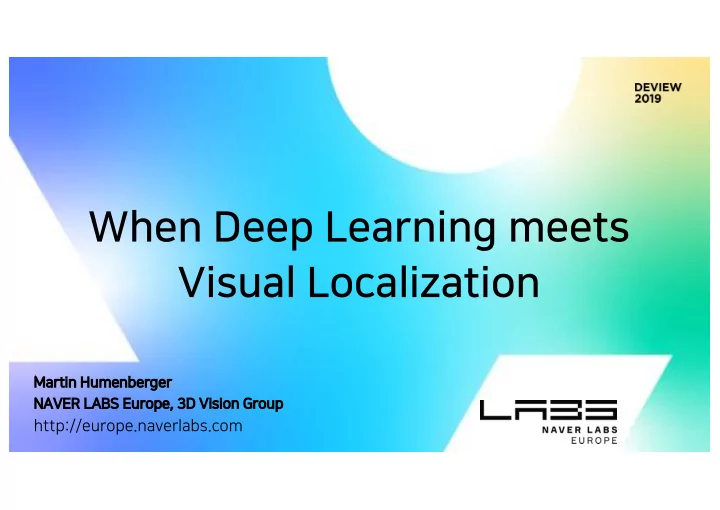

When�Deep�Learning�meets Visual�Localization Mar Martin�Hu Humenberger NA NAVER�LA LABS� BS�Eur urop ope,�3D 3D�Vision on�Gr Group oup http://europe.naverlabs.com
Outline 1.�3D�Vision�@�NAVER�LABS�Europe 2.�Visual�Localization:�Concept,�Methods,�Datasets 3.�Local�Feature�Extraction�(R2D2) 4.�VSLAM�in�Dynamic�Environments�(Slamantic)
3D�VISION�at�NAVER�LABS�Europe
3D�Vision� Research�Interests We�want�to�overcome�current�limitations�of�traditional,�mainly�geometry-based,�methods�of�3D� vision�using�data�driven�machine�learning�techniques. Main�r �research�t �topics: a) Fundamental�methods�of�3D�vision • Correspondence�analysis • Depth�estimation b) Camera�pose�estimation • Visual�localization • VSLAM�/�VO c) 3D�scene�understanding • Semantic�mapping • 3D�reconstruction d) Synthetic�datasets�and�domain�adaptation • Transfer�between�synthetic�and�real�world
Visual�Localization
Visual�Localization�- Concept GPS�accuracy sometimes�not�enough. E.g.�for�precise�robot�navigation�or� augmented�reality. Ch â teau�de�Sceaux Goal:�Use�an�image�to�estimate�the� pr precise position�of� the�camera�within�a�given�area�(map).
Visual�Localization�- Concept This�works�indoor�as�well! There,�it�is�in�particular�useful�since�GPS�is�not�available.� Vi Visual� al� Lo Localiza zation
Application�Examples
Methods�of�Visual�Localization
Challenges�of�Visual�Localization illumination viewpoint�and�scale reference�image�(map) occlusion viewpoint,�occlusion,�weather
Structure�Based�Visual�Localization 3D�Map 2D�Input�Image Take�a�picture Descriptor�matching�to�get� Camera�pose� Feature�detection�&� Location Input�image 2D-3D�correspondences estimation description
Image�Retrieval�Based�Visual�Localization Large 3D Map 2D Input Image Descriptor matching to get Camera pose Image retrieval Location Input image 2D-3D correspondences estimation
Camera�Pose�Regression�Based�Visual�Localization No 3D Map but… image camera�pose image camera�pose CNN image camera�pose
Camera�Pose�Regression�Based�Visual�Localization 2D Input Image CNN CNN to directly estimate Location Input image the camera pose
Scene�Coordinate�Regression�Based�Visual�Localization 3D�Map 2D�Input�Image Take�a�picture CNN�to�regress�dense� Camera�pose� Feature�detection�&� Location Input�image 2D-3D�correspondences estimation description
Overview�of� Methods + Perform very�well�on�most�datasets�->�high�accuracy St Stru ructure-ba based� Active�Search�[1] - meth methods ds OpenMVG [2] Not�suitable�for�very�large�environments�(memory�and� processing�time) + Improve speed�and�robustness�for�large�scale�settings Image�r �retrieval-ba based� HF-Net�[3] - meth methods ds Quality�heavily�relies�on�image�retrieval + Interesting�approach�because�no�3D�maps�are�needed�and it�is� Camera�p �pose� PoseNet [4] regression�m �methods data�driven�(can�be�trained�for�certain�challenges) - Low�accuracy + Very�accurate�in�small�scale�settings Scene�c �coordinate� DSAC++�[5] - regression�m �methods Does�not�yet�work�in�large�scale�environments [1]�T.�Sattler�et�al.,�Improving�Image-Based�Localization�by�Active�Correspondence�Search,�ECCV�2012 [2]�P.�Moulon,�OpenMVG:�http://github.com/openMVG/openMVG [3]�Sarlin et�al.,�From�Coarse�to�Fine:�Robust�Hierarchical�Localization�at�Large�Scale,�CVPR�2019 [4]�A.�Kendall�et�al.,�PoseNet: http://mi.eng.cam.ac.uk/projects/relocalisation/,�ICCV�2015 [5]�E.�Brachmann et�al.,�Learning�Less�is�More� 6D�Camera�Localization�via�3D�Surface�Regression,�CVPR�2018
Mapping�with�M1X
NAVER�LABS�Mapping�Robot�M1X Mean Matching Accuracy (MMA)
Mean Matching Accuracy (MMA)
Mapping�with�Structure�from� Motion
Structure�from�Motion J.�Sch ö nberger,�Robust�Methods�for�Accurate�and�Efficient�3D�Modeling�from�Unstructured�Imagery,�PhD,�ETHZ
Structure�from�Motion http://imagine.enpc.fr/~moulonp/openMVG/ https://demuc.de/colmap/
Datasets
Datasets – Cambridge Landmarks – Outdoor Localization • 8,000 images from 6 scenes up to 100 x 500m RG RGB,�SfM SfM Alex Kendall, Matthew Grimes and Roberto Cipolla. PoseNet: A Convolut utiona nal Network for Real-Ti Time 6-DOF Camera Relocalization. n. ICCV, 2015. Slide�credit�Alex�Kendall,�https://pdfs.semanticscholar.org/4fc6/7b4dc62e9c8eee4259c3878b71c64958c373.pdf
Datasets – Seven Scenes – Indoor Localization • 17,000 images across 7 small indoor scenes. RGB-D, pose, dense reconstruction Jamie Shotton et al. Scene coordinate regression forests for camera relocalization in RGB-D images. CVPR 2013 Slide credit Alex Kendall, https://pdfs.semanticscholar.org/4fc6/7b4dc62e9c8eee4259c3878b71c64958c373.pdf
Aachen�Day-Night Old�inner�city�of�Aachen,�Germany - 4328�reference�images - 922�query�images�(824�daytime,�98�nighttime) - All�images�are�captured�with�hand-held�cameras 3D�reconstruction�(sfm) training�image�examples test�image�examples�(day�- night)
Baidu�IBL�Dataset - Captured�in�a�shopping�mall�using�high�res� cameras�and�a�lidar scanner - RGB�(training�and�testing),�point�clouds,�poses� Su Sun�et�al.,�A�Da Datase set�for�Be Benchmarking� g�Image ge-Ba Base sed�Localization,�CVP CVPR1 R17
Virtual�Gallery� Synthetic�Dataset
Virtual�Gallery� Synthetic�Dataset Tailored�to�test�specific�challenges�of�visual� localization,�such�as:� • Different�lighting�conditions • Occlusions • Various�camera�parameters Training:� • Imitate�a�robot�scanning�the�museum • 6�cameras�(360º),�1�virtual�lidar • 5�trajectories Testing: • Imitate�pictures�taken�by�people • Cameras�:�Random�intrinsics,�random�orientation,�random� position • Different�lighting�conditions�and�occlusions Download:�https://europe.naverlabs.com/research/3d-vision/virtual-gallery-dataset/
Visual�Localization�using�Objects�of� Interest
Pu Publ blished�a shed�at�C t�CVPR VPR19� Objects�of�Interest�(OOI)�are�distinctive�areas�within�the�environment�which�can�be�detected� under�various�conditions.�
Publ Pu blished�a shed�at�C t�CVPR VPR19� Main�advantage: - list�of�all�OOIs� Map�=� Data�driven�approach� - 3D�locations�of�OOIs which�can�overcome� common�VL�challenges. 3)�Use�correspondences�to� 1)�Start�with�input�image 2)�Feed�into�OOI�network compute�the�camera�location
Localization�Results� Baidu�Dataset • Structure-based�methods�perform�best. • Learning-based�methods�(PoseNet,�DSAC++)�do�not�work�on�this�large�dataset. • Our�approach�is�the�first�learning-based�method�which�can�be�applied�here. Paper:�https://europe.naverlabs.com/research/publications/visual-localization-by-learning-objects-of-interest-dense-match-regression/
Local�Feature�Extraction R2D2� Repeatable�and�Reliable� Detector�and�Descriptor
Motivation • Structure-based�methods�perform�well�and�the�critical�part�is�feature�extraction�and� matching. • A robust�feature�detector�enables�robust�visual�localization • ...�and�improves�many�other�applications�such�as�object�detection,�VSLAM�and�SfM.
Overview Csurka et�al.,�From�handcrafted�to�deep�local�features,�arXiv 2018
Introduction - Classical�methods: Detect- then then -describe ! Extract Patch Keypoint patches descriptor detector 3)�Describe�keypoints 1)�Start�with�input�image 2)�Detect�keypoints
Introduction - Classical�methods: Detect- then then -describe - Our�approach:� Detect- an and -describe Keypoints (nms) ! descriptor� for�each�keypoint 3)�Detect�keypoints &� 1)�Start�with�input�image 2)�Feed�into�R2D2�network describe�them�at�once
Recommend
More recommend